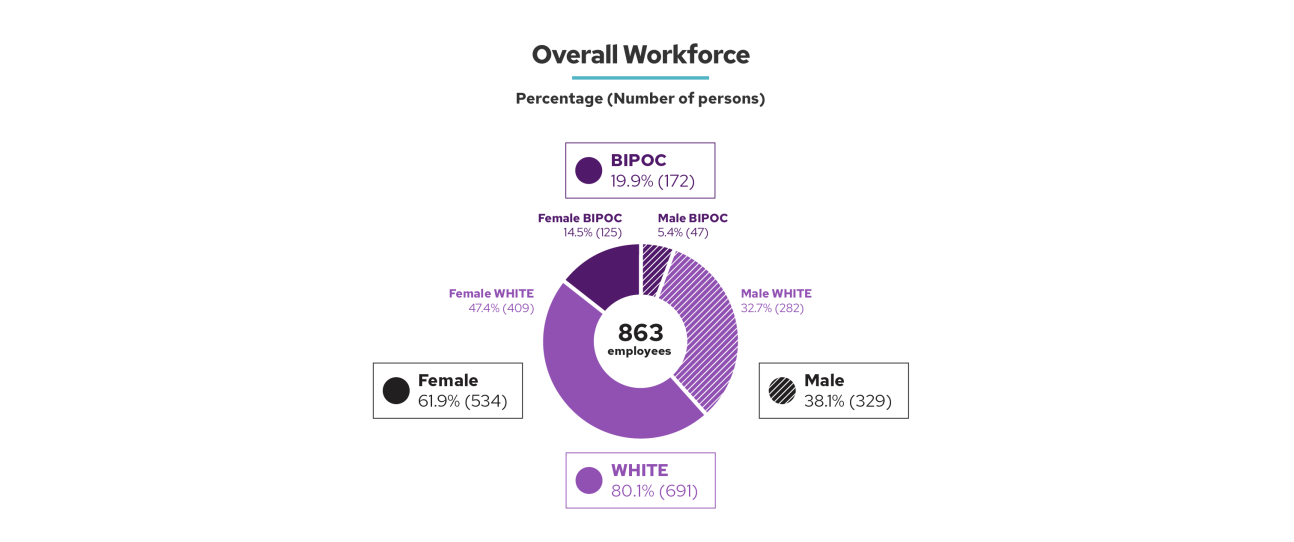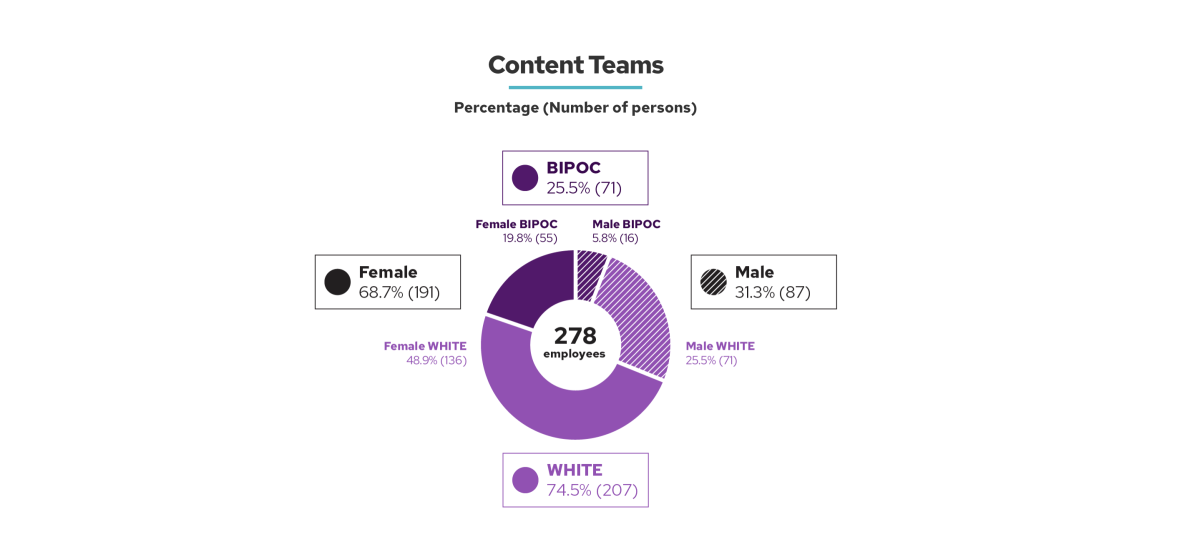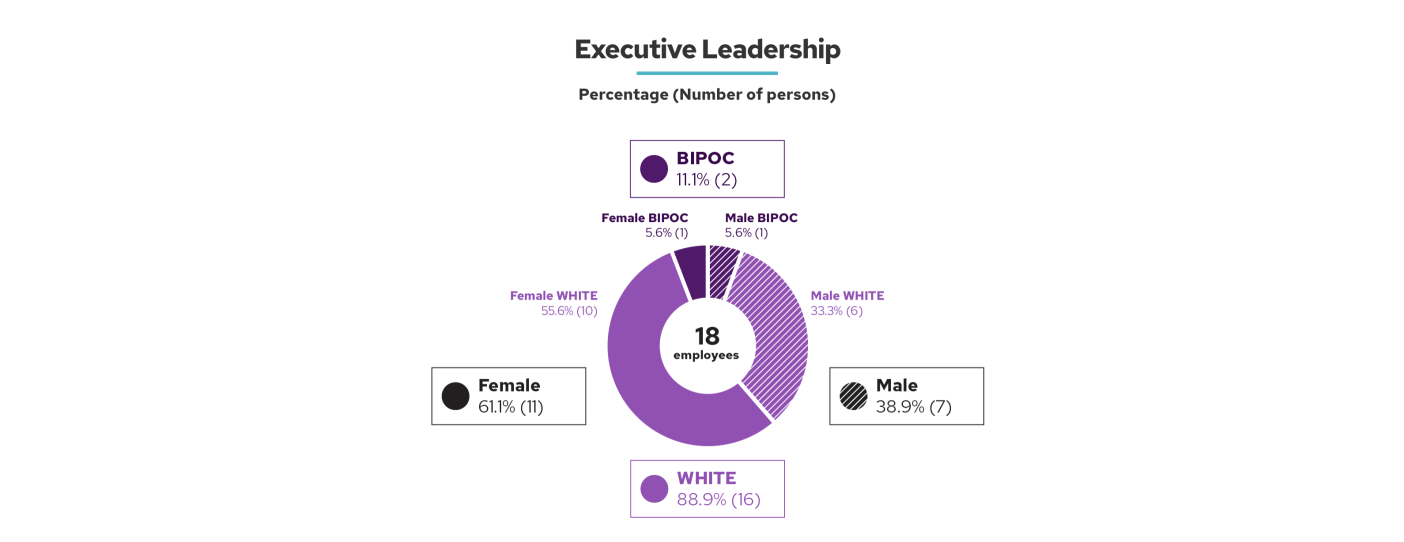GBH’s workforce is 80% white, according to data released by the organization in July. The 863 employees span departments such as TV, radio, digital news, event planning, human resources and more. Racial diversity is lower among the executive team, which is 89% white, higher among content producers and higher among advisory and fiduciary boards.
Jon Abbott, the president and CEO of GBH, discussed the data with Arun Rath on GBH’s All Things Considered Tuesday.
“To be 20% diverse wasn’t terrifically surprising to me,” he said. “It was disappointing, and obviously we are going to be working on that part of our representation of diverse staff, with regards to race, over the next few years. And I think, I know, in the last year we’ve made a range of investments in our recruiting, in our outreach and training and our work across our staff.”
Abbott said that the organization is also looking at the diversity of its sources in GBH’s nonfiction content.
“It’s not just our workforce, but we know that if we only had white men as scholars, speaking to camera as voices of authority in our documentaries, we would be misrepresenting the scholarship and expertise and the breadth of experience,” he said. “And also, frankly, disempowering our diverse audience because they’re not, in those instances, they’re not seeing themselves accurately and proportionately represented.”
The importance for public media organizations such as GBH to reflect its audience and community is particularly important, Abbott noted.
“Public media is a remarkable resource across the country, and it’s built on accountability and trust,” he said. “And I think we’ve all recognized over the last year or two, of course, given the reckoning, that it’s a wake-up call. That for us to do our work effectively, we have to be better at representing, and working hard every day, at representing the communities and serving the communities we serve in their full diversity and experience.”
“This is the first step we are taking, and it’s going to have our attention in the months ahead, in the years ahead, because I don’t think we’re going to take our attention off of it,” he continued. “I know we won’t.”
What follows is a lightly edited transcript of the interview with GBH CEO and President Jon Abbott. The data collected on GBH’s racial and gender diversity can be seen here.
Arun Rath: This is GBH 89.7. I’m Arun Rath. Over the last year, as the social justice movement has been recharged by the reaction and protests following the murder of George Floyd, a lot of businesses and professions have been engaged in some powerful self scrutiny when it comes to diversity and inclusion. That’s especially true of outward-facing businesses like the performing arts and media — and public broadcasting.
To be blunt, public radio and public TV do not have a great record on diversity. I can vouch for that from personal experience, as a person of color who spent his whole career in public radio and public TV. But we are also engaged in self scrutiny in public broadcasting, including here at GBH, and GBH has just completed a study of our workforce and boards. Better still, GBH has made the data public. Here to discuss all this is Jon Abbott, president and CEO of GBH. John, welcome.
Abbott: Thanks very much, Arun. Grateful to be with you.
Rath: And I really appreciate you coming on to us to talk about this.
Abbott: Well, you know, it’s an essential part of the work we do. And I know that, as you observed, many organizations and institutions recognize that the legacy of structural racism and the barriers to full inclusion of everyone across our community — and in opportunity actually — really requires of every organization and every group, hopefully, the level of effort and scrutiny and attention to progress that we all need to put in.
Rath: So let’s, at the top, just talk about the awkward side here, stipulate what’s awkward. So, you know, obviously you’re my boss. We’re reporting on ourselves. As a person of color and GBH employee, I have a sort of subjectivity involved. So, as a journalist, I just need to lay all that on the table.
And also, I think we should be clear with our listeners at the top here, you know, who are listening to this on GBH radio or the app or the livestream, when Jon and I are talking about GBH, we’re talking about all of GBH, not just the radio side. TV, radio, web content, national, local. It’s a lot, you know. NOVA, Frontline, Antiques Roadshow, various programs on PBS Kids, more things than I can reasonably recite right now. Jon, roughly how many employees are we talking about?
Abbott: We have over 800 employees working, as you say, across all of the things that GBH is busy doing, both in our regional communities here in New England and eastern New England, and then, of course, as you know, we’re one of PBS’s largest producers, both of general audience and children’s content and media, so, yeah, over 800.
Rath: And for the context to start off, in talking about diversity and inclusion in public broadcasting — and as I mentioned, you know, some industries are better than others — and I seem to think there’s a consensus, when it comes to public broadcasting, that things have not been great in terms of diversity, especially racial diversity. Would you agree with that?
Abbott: Yes. I mean, I think that, when we look at the data and look at the track record of being able to attract and build a workforce that is representative of our community at large — and have a diverse community, both working on the projects and reflected in the subject matter that we produce — there’s work to do. We have not made the progress, I know many of us feel over the last few decades, consistent with the progress many people thought was, of course, the aspiration of the civil rights movement: that our workforces would be more representative of our communities.
And that’s especially important in media — and especially for public media, because our mission is storytelling and fully representing the important stories and voices of our time. And, as importantly, having our audience and our community feel that they are reflected in the work. So I think this is something, it’s core to our mission, and it’s something we have to do more work on and we have been doing more work on, and we will continue to focus on in the years ahead.
Rath: And with that, it makes sense to do this kind of study, to look at the actual numbers on diversity and inclusion. In reality, though, a lot of people, especially people of color, would like to see these numbers. But not many organizations have shown a lot of inclination to collect this data, let alone share it. Could you maybe say why that might be, and and why GBH is releasing this data now?
Abbott: Well, I can’t speak to others. I mean, in our case, we felt it was fundamental to our commitment to accountability and transparency as we work towards our goal of representing and reflecting the communities we serve. And that’s both through our work and the work we do, and the people who do it. And we felt, you know, there’s that old adage: what gets measured, gets attention — and gets worked on.
And I think, in part, we wanted, you know, for me, the important characteristic of public media, which is the last locally owned, operated and governed media in this country, it’s all the more important for organizations like ours to step forward and to be accountable for the progress we need to make. And that was our thinking. And I think it focuses us on — has focused us over the last year, year and a half — and we’ve made some progress, but we know there’s lots of progress ahead that we’ve got to achieve.
Rath: And one more thing, before we talk about the numbers, this was a part of an involvement in this group called Public Media for All. And I’m wondering if you could tell people about that, what Public Media for All is and why GBH joined?
Abbott: Yeah, we joined — this is a group of colleagues, professionals across the public media, community, public radio, television — the work now being done in digital media from all parts of the country. We recognize that all of us are on a journey, and want to do the constructive work, the progressive work, to diversify our workforces and make sure that, in our community of makers and the stories we tell, that we’re representing our communities, be it, you know, west or east or north or south.
And so what Public Media for All is doing is, there’s a phrase I like to use called 'community of practice.’ And if you can find a group of colleagues who are really committed to making progress, and who can share their experiences and compare their ideas — compare the experiences they’ve had, the progress they’ve made, the struggles they’ve had — we all then learn from each other. And I think that will accelerate our insight, hopefully our innovation and hopefully our progress. So, what we’re trying to do with Public Media for All and in joining, is joining with, you know, hundreds of others in building this community of those who will stay focused on the issue of diversity and inclusion going forward.

Rath: So, as Kai [Ryssdal] likes to say on Marketplace, let’s run through the numbers. And I’ll mention, right in the body here of this interview that, you know, there will be a longer version of this interview up on the web, because we’re going to talk about a lot of stuff and we won’t have time to get to all of it in the broadcast, because it’s fascinating.
So, as we’re talking about about these numbers, let me just also say at the outset that I’m going to focus on race. Not that gender isn’t something that we should be talking about, but generally, the balance in public broadcasting is pretty good. Looking at the overall workforce at GBH, I have the graphic in front of me — and people can go to our website and all these numbers are posted publicly. You can check them out. And they’re both numbers for 2019 and 2020. The overall workforce is 80% white. Well, first off, let me ask you, looking at this generally, were there surprises for you? What’s your general take on the numbers?
Abbott: Well, as we were reviewing the numbers — and we’ve generally tried to look at them every year — I wasn’t terrifically surprised. As you may note, also, in addition to the overall workforce numbers, we also broke down areas of the organization, and particularly focused on our progress with hiring and how diverse our hiring has been over the last two years.
So, to be 20% diverse wasn’t terrifically surprising to me. It was disappointing, and obviously we are going to be working on that part of our representation of diverse staff with regards to race over the next few years. And I think — I know — in the last year, we’ve made a range of investments in our recruiting, in our outreach and training and our work across our staff that I think is going to reinforce, hopefully, the progress we’ll see increasing our representation above that 20% overall.

Rath: And let’s look at some of the areas, the individual areas, that may bebetter or worse. For the content teams — that that would be, you know, again, across media, but people who do work like we’re doing on this show — the numbers are a bit better: 25% BIPOC. And we have about 74.5% white.
Abbott: Right. And obviously, this is an area of particular focus for us, because these are our editorial teams who are working on the projects that we work on, both for our region and very much so nationally. So each of our editorial teams and our departments have goals with regards to diversity, equity and inclusion, and the advantage of breaking out the data is to work — we’re going to be working across the organization, with every department, with every team, to identify the opportunities they have to diversify their workforce.
And the other aspect on the content side, of course, is it’s not just the people, the teams doing the work; it’s also the colleagues we collaborate with to make our films, and also the subject matter material, the topics we attend to. So we’re not only going to be looking at, over time — this is kind of a first cut at this data — but we also know that that same attention to inclusion, representation and diversity has to be reflected in the stories we tell.
So across our departments, we’re also — our definition of looking after this question of inclusion and diversity includes the stories we tell and frankly, who’s telling them. For example, in the case of NOVA, which is the leading science series in the country, over the last two or three years, there’s been a substantial amount of work that the NOVA producers have done, recognizing the importance of representation, to make sure that the scholars who are really the backbone of any NOVA story that we produce, to make sure that the scholars are accurately reflecting the extraordinary diversity of scholarship and scholars in our country. So that’s the kind of in-front-of-the-camera question. So it’s not just our workforce.
But we know that if we only had white men as scholars speaking to camera as voices of authority in our documentaries, we would be misrepresenting the scholarship and expertise and the breadth of experience and also, frankly, disempowering our diverse audience, because they’re not — in those instances — they’re not seeing themselves accurately and proportionately represented.

Rath: Looking higher up at the executive leadership, those numbers are not as good. It’s at 11% brown, indigenous people of color.
Abbott: Yes, and that’s a circumstance, of course, of the last few years, and hires — some people that have come onto our executive team. And it is, we did break it out, because we think that it’s critical to continue to look at all levels of the organization, especially at the executive suite — the people who lead the organization. One of the commitments we made over the last year, and fulfilled as part of our attention to this question this past year, was adding for the first time in our history a chief inclusion and equity officer. So, not reflected in the numbers is a very talented executive we brought in to help lead and orchestrate our efforts across the organization. And we recognize that, with each opportunity we have to diversify the executive ranks of the organization, we’re going to — just as we’ve asked this of every other part of GBH, we will do the same with the executive team.

Rath: And again, looking at the less visible part of an organization, I’m going to maybe end by talking about the board of trustees and board of advisors, where the numbers aren’t terrible. Board of advisors, you know, the brown, indigenous people of color, 34%, which is a bit more than I would have expected — I don’t know why I would have expected, or what I would have expected, necessarily — and the board of trustees, similar, 36.7%. But if you could frame that and explain it to people, because the listener may not have any idea — or maybe even those of us who work here — what the boards do, the board of advisors, and board of trustees, and why they are important?
Abbott: Well, they’re a vital part of GBH, and I’m very, I’m proud with the progress we’ve made over the last four or five years in diversifying both the board of advisers and board of trustees. The board of advisors are a group of 50 or so individuals who serve as ambassadors for GBH, and through their work on the board, meet with our executive team and staff to talk about our work and help us, in effect, inform and guide our work and the future of public media. And the board of trustees are our fiduciaries. This is our governing board. And as you mentioned, they are slightly even more diverse.
These are volunteer leaders from the community who, in effect, provide the guidance and oversight for the organization. And it’s been an area that we’ve been working very intently on over the last few years, diversifying that group. And we have remarkable, remarkable boards in both cases, with a very special array of talents that, you know, as with any nonprofit — and you were talking about other nonprofits earlier — you know, we all rely on drawing upon community leaders and volunteers who bring a range of experiences to our boards, for counsel and for leadership. And so, not unlike the staff, it is vitally important that those boards are diverse and they reflect the extraordinary range of leadership across the community, and hopefully bring that diversity of life experience and points of view to the table so that we can do our work more effectively.
Rath: Jon, once again, really appreciate you coming on and talking about this in this amount of detail, and I feel like I need to flag for our listeners, that, honestly, CEOs of public or private companies don’t like, right now, coming on and talking about this kind of stuff in this kind of detail. It’s a big deal to be able to talk with you, and that transparency and openness, we appreciate it. Thank you.
Abbott: Well, I appreciate having the chance to speak to our audiences. And, you know, we’re — public media is a remarkable resource across the country, and it’s built on accountability and trust. And I think we’ve all recognized over the last year or two, of course, given the reckoning, that it’s a wake-up call. That for us to do our work effectively, we have to be better at representing — and working hard every day — at representing the communities and serving the communities we serve in their full diversity and experience. So, I appreciate being asked, and I know this is the first step we are taking, and it’s going to have our attention in the months ahead, in the years ahead, because I don’t think we’re going to take our attention off of it. I know we won’t.
Rath: We’ll talk again, on the show and off.
Abbott: Thanks. Take care, Arun.
Rath: Jon Abbott is the president and CEO of GBH. This is GBH’s All Things Considered.







